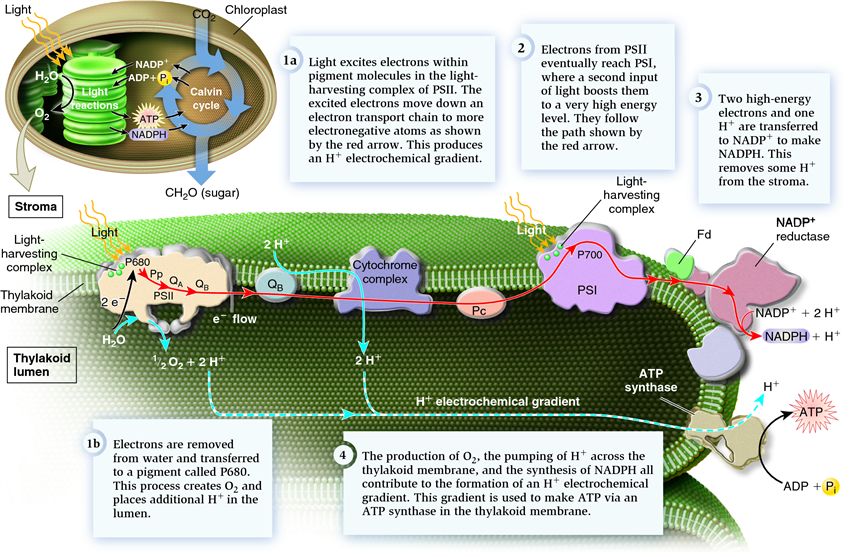 |
| Previous Image | Next Image |
| Description: The synthesis of O2, ATP, and NADPH by the concerted actions of photosystems II and I. The key role of photosystem I is to make NADPH. When light strikes the light-harvesting complex of photosystem I, this energy is also transferred to a reaction centre, where a high-energy electron is removed from a pigment molecule, designated P700, and transferred to a primary electron acceptor. A protein called ferredoxin (Fd) can accept two high-energy electrons, one at a time, from the primary electron acceptor. Fd then transfers the two electrons to the enzyme NADP+ reductase. This enzyme transfers the two electrons to NADP+ and together with an H+ creates NADPH. The formation of NADPH consumes one H+ in the stroma and thereby contributes to the formation of an H+ electrochemical gradient because it results in fewer H+ in the stroma. A key difference between photosystem II and photosystem I is how the oxidized forms of P680 and P700 receive electrons. As discussed earlier, P680+ receives an electron from water. By comparison, P700+ ? the oxidized form of P700â€â€Âreceives an electron from Pc. Therefore, photosystem I does not need to split water to reduce P700+ and thus does not generate oxygen. In summary, the two light-harvesting events in photosynthesis are usually coupled to produce three chemical products: O2 is produced in the thylakoid lumen by the oxidation of water by photosystem II. Two electrons are removed from water, which creates two H+ and 1/2 O2. The two electrons are transferred to P680+ molecules. ATP is produced in the stroma by an H+ electrochemical gradient. This gradient results from three events: (1) the splitting of water, which places H+ in the thylakoid lumen; (2) the movement of high-energy electrons from photosystem II to photosystem I, which pumps H+ into the lumen; and (3) the formation of NADPH, which consumes H+ in the stroma. NADPH is produced in the stroma from high-energy electrons that start in photosystem II and are boosted a second time in photosystem I. Two high-energy electrons and one H+ are transferred to NADP+ to create NADPH. The combined action of photosystem II and photosystem I is termed noncyclic electron flow because the electrons move linearly from PSII to PSI and ultimately to NADP+. Picture Stats: Views: 3322 Filesize: 124.87kB Height: 557 Width: 850 Source: https://biology-forums.com/index.php?action=gallery;sa=view;id=355 Keywords: The synthesis of O2, ATP, and NADPH by the concerted actions of photosystems II and I |
